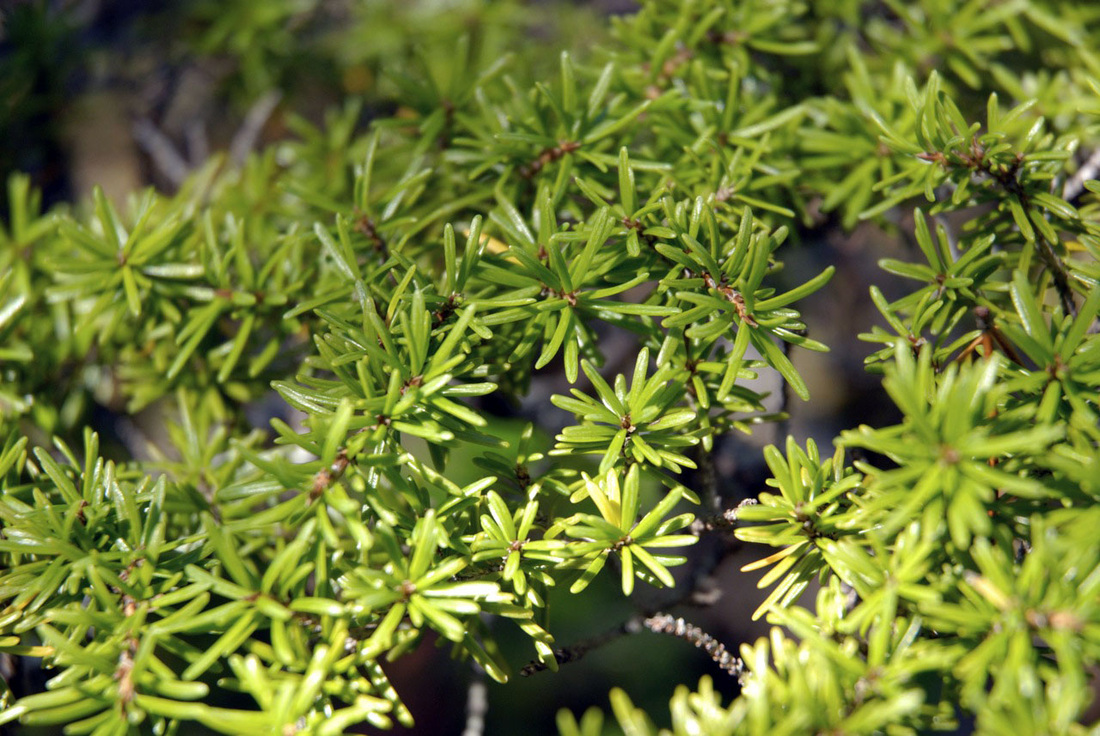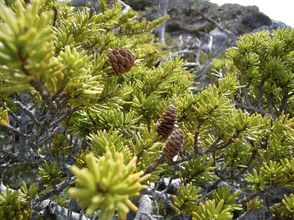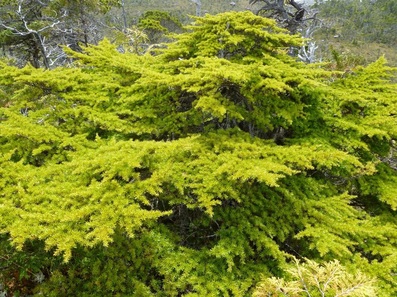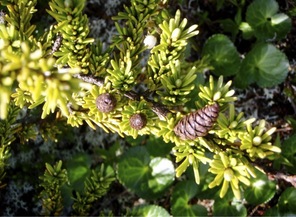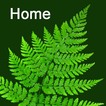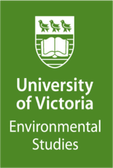Mountain hemlock • Tsuga mertensiana
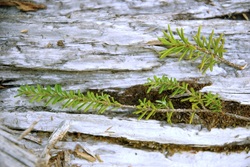 A comparison of mountain hemlock (top) and western hemlock needles (bottom). Photo by Kelly Fretwell.
A comparison of mountain hemlock (top) and western hemlock needles (bottom). Photo by Kelly Fretwell.
Identification
Mountain hemlock is a coniferous tree that can grow up to 40 m tall, but is often stunted by elevation or soil conditions in certain habitats. The leader (top) of the tree droops slightly, but not as much as the top of the western hemlock (Tsuga heterophylla). The bark is thick and furrowed, and purplish to reddish-brown. The needles grow from all angles around each branch, forming a circular arrangement in cross-section. They are also all the same length. This species has two types of cones: pollen cones which are blueish, and seed cones that are purplish-brown. The cones are 3-8 cm long.
Habitat & Range
Mountain hemlock grows in bogs and other wet sites. In the southern part of its range it is generally found at subalpine to alpine elevations, but in more northern areas, including the Central Coast, it is often found at lower elevations. Its range extends north to Alaska, south to California, and inland to Idaho and Montana and parts of interior British Columbia.
Similar Species
Mountain hemlock is quite similar to western hemlock (Tsuga heterophylla), which is more common and generally found at lower elevations. The two species can be distinguished by their needles and cones. Western hemlock has needles of varying lengths that only grow out of the sides of the branch, so they lay flatter — as opposed to the circular branches of mountain hemlock, with needles pointing in all directions. The cones of western hemlock are also much smaller, only reaching about 2 cm long. Western hemlock is not usually found at higher elevations.
Human Uses
Mountain hemlock is used as an ornamental plant in North American and Europe. It is tolerant of severe weather, but grows slowly at low elevations.
Intriguing Info
If mountain hemlock forms thick stands, the lower branches may appear to be those of western hemlock, with the needles flattening out. The upper branches will generally retain their usual form, however. The two species can also co-occur in forests with mountain hemlock as the overstory species, and western hemlock underneath.
Mountain hemlock is a coniferous tree that can grow up to 40 m tall, but is often stunted by elevation or soil conditions in certain habitats. The leader (top) of the tree droops slightly, but not as much as the top of the western hemlock (Tsuga heterophylla). The bark is thick and furrowed, and purplish to reddish-brown. The needles grow from all angles around each branch, forming a circular arrangement in cross-section. They are also all the same length. This species has two types of cones: pollen cones which are blueish, and seed cones that are purplish-brown. The cones are 3-8 cm long.
Habitat & Range
Mountain hemlock grows in bogs and other wet sites. In the southern part of its range it is generally found at subalpine to alpine elevations, but in more northern areas, including the Central Coast, it is often found at lower elevations. Its range extends north to Alaska, south to California, and inland to Idaho and Montana and parts of interior British Columbia.
Similar Species
Mountain hemlock is quite similar to western hemlock (Tsuga heterophylla), which is more common and generally found at lower elevations. The two species can be distinguished by their needles and cones. Western hemlock has needles of varying lengths that only grow out of the sides of the branch, so they lay flatter — as opposed to the circular branches of mountain hemlock, with needles pointing in all directions. The cones of western hemlock are also much smaller, only reaching about 2 cm long. Western hemlock is not usually found at higher elevations.
Human Uses
Mountain hemlock is used as an ornamental plant in North American and Europe. It is tolerant of severe weather, but grows slowly at low elevations.
Intriguing Info
If mountain hemlock forms thick stands, the lower branches may appear to be those of western hemlock, with the needles flattening out. The upper branches will generally retain their usual form, however. The two species can also co-occur in forests with mountain hemlock as the overstory species, and western hemlock underneath.
References
Pojar, J. and MacKinnon, A. (2005). Plants of Coastal British Columbia, Revised. Vancouver, BC: Lone Pine Publishing. P. 31.
Spurgeon, C. (2012). Mountain Hemlock for Lowland Gardens. Botanical Rambles: Washington Native Plant Society blog. Accessed 27/04/2013.
Tsuga mertensiana (Bong.) CarriΦre. mountain hemlock. In Klinkenberg, Brian. (Ed.). E-Flora BC: Electronic Atlas of the Plants of British Columbia. Lab for Advanced Spatial Analysis, Department of Geography, University of British Columbia, Vancouver. Accessed on 27/04/2013.
Authors and editors of page
Chanda Brietzke, Kelly Fretwell, and Brian Starzomski (2016).
Pojar, J. and MacKinnon, A. (2005). Plants of Coastal British Columbia, Revised. Vancouver, BC: Lone Pine Publishing. P. 31.
Spurgeon, C. (2012). Mountain Hemlock for Lowland Gardens. Botanical Rambles: Washington Native Plant Society blog. Accessed 27/04/2013.
Tsuga mertensiana (Bong.) CarriΦre. mountain hemlock. In Klinkenberg, Brian. (Ed.). E-Flora BC: Electronic Atlas of the Plants of British Columbia. Lab for Advanced Spatial Analysis, Department of Geography, University of British Columbia, Vancouver. Accessed on 27/04/2013.
Authors and editors of page
Chanda Brietzke, Kelly Fretwell, and Brian Starzomski (2016).
